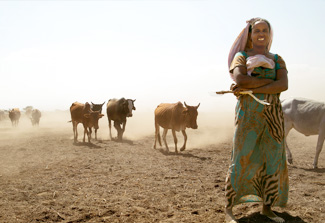GEOHealth hub studies climate change in East Africa
September/October 2021 Volume 20 Number 5
 Photo by Nancy McNally/Catholic Relief Services
Photo by Nancy McNally/Catholic Relief Services
Four East African countries have produced climate change needs assessments
for their countries through the Fogarty-managed GEOHealth program.
Climate change-related health problems due to droughts,
floods, heat waves, and vector- and water-borne diseases
are increasingly affecting the world’s most vulnerable
populations. Scientists in four East African countries have
conducted studies of these complex issues, developed
needs assessments and provided guidance to policymakers
on how to address them. The research projects—which may
serve as models for other countries—were supported by the
Fogarty-led Global Environmental and Occupational Health
(GEOHealth) program.
Rising temperatures have already begun to take their
toll on Ethiopian health, said Dr. Belay Simane, the lead
author of his country’s study, which was published in the
Ethiopian Journal of Health Development. Ethiopia’s annual
temperature has already risen more than 1.3° Celsius since
1960 and models suggest it could climb as much as 2.9°
Celsius more by the 2050s. A warming planet has caused
repeated droughts, floods and extreme temperature events
in Ethiopia over the past few decades, explained Simane,
who is a scientist at Addis Ababa University. Water scarcity
leads to inadequate hygiene, which results in fecal-oral
transmission of diseases. Meanwhile, floods are expected
to become more frequent and more severe under most
scenarios. Given that Ethiopia relies heavily on pit latrines,
flooding can contaminate surface, ground and drinking
water. An epidemic of cholera followed flooding in 2006,
leading to widespread illness and loss of life. Diarrhea, a
leading cause of infant mortality, is becoming a growing
health risk, noted Simane.
Hotter temperatures also spur climate-sensitive illnesses,
including vector-borne diseases that require optimal
ground, air and water temperature for the survival and
reproduction of insects, Simane said. “The more the
temperature increases, let’s say, 0.5° Celsius every 10
years, the larger the area of vector-borne disease—and
the longer the transmission period—becomes.” Malaria,
customarily prevalent in the lowlands, is moving into the
highlands. The WHO estimates 68% of Ethiopians are now
at risk of malaria. Other vector-borne diseases, notably
dengue and visceral leishmaniasis, are already escalating
due to climate change, Simane observed.
Water-borne and zoonotic diseases are increasing as
well. Bacteria that live in water are more apt to multiply
in warmer temperatures, while helminthic infections like
hookworm (transmitted through soil) follow a similar
pattern, said Simane. Zoonotic infections are already
escalating. Currently, the nation has the fourth highest
burden of zoonoses, which cause an estimated one-fifth of
all human infectious diseases in low-income countries.
Add to this the fact that global warming intensifies
humidity and dust levels, two factors that increase the risk of meningitis outbreaks. Ethiopia sits within sub-Saharan
Africa’s “meningitis belt” and Simane’s study reported
certain types of meningitis have been diagnosed beyond
those regions traditionally prone to the disease.
Yet, it is climate change’s effects on agriculture and
nutrition that pose the greatest threat, said Simane. Heat
stress has a negative impact on the crops themselves while
also curtailing workers’ productivity. Some crops are no
longer viable in higher temperatures, forcing a reliance
on carbohydrates. The number of people sickened due to
malnutrition will be greater than those affected by malaria
and other climate-sensitive diseases, stated Simane.
Addis Ababa University leads the eastern Africa
GEOHealth hub, which includes universities in Kenya,
Rwanda and Uganda. The hub’s members meet regularly
to share findings and all have completed similar national
situational and needs assessment studies. The hub’s
Principal Investigator, Dr. Abera Kumie, believes these
reports can serve as blueprints for other low-resource
countries seeking to clarify the impact of climate change
and identify gaps in research, training and capacity.
The need for more research—and researchers—is urgent
so that interventions can be developed and implemented,
said Kumie. “The whole point of our project, our research,
is to produce evidence that could influence policy change.”
The East Africa hub has been supported by Fogarty, the
NIH’s National Institute of Environmental Health Sciences,
the CDC’s National Institute for Occupational Study and
Health, and Canada’s International Development Research
Centre.
More Information
To view Adobe PDF files,
download current, free accessible plug-ins from Adobe's website.
Related Fogarty Programs
Related World Regions / Countries
Related Global Health Research Topics